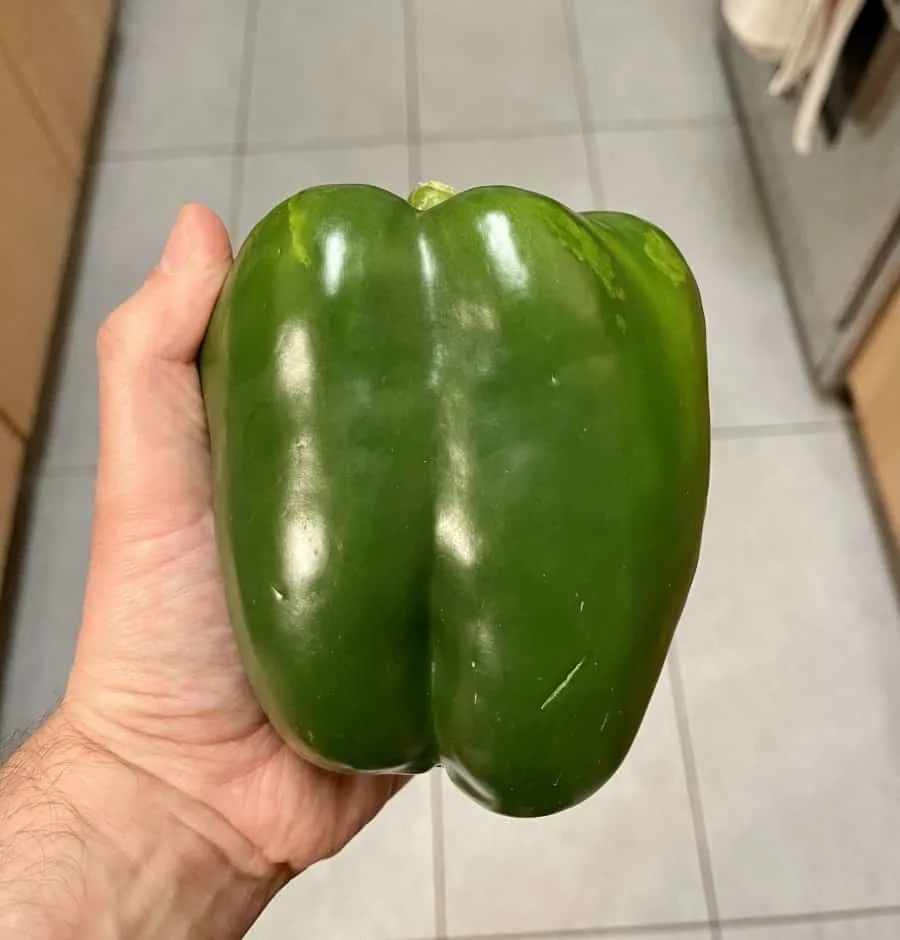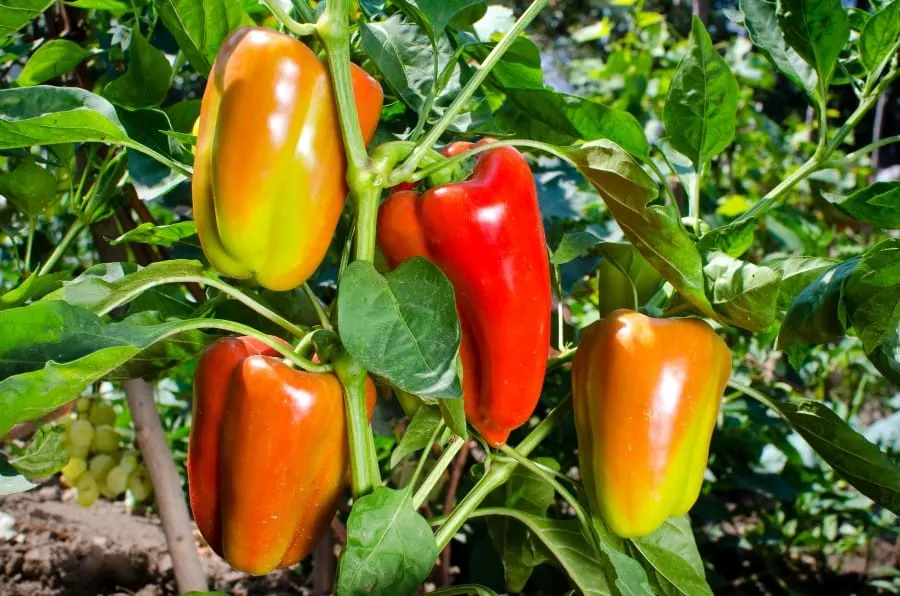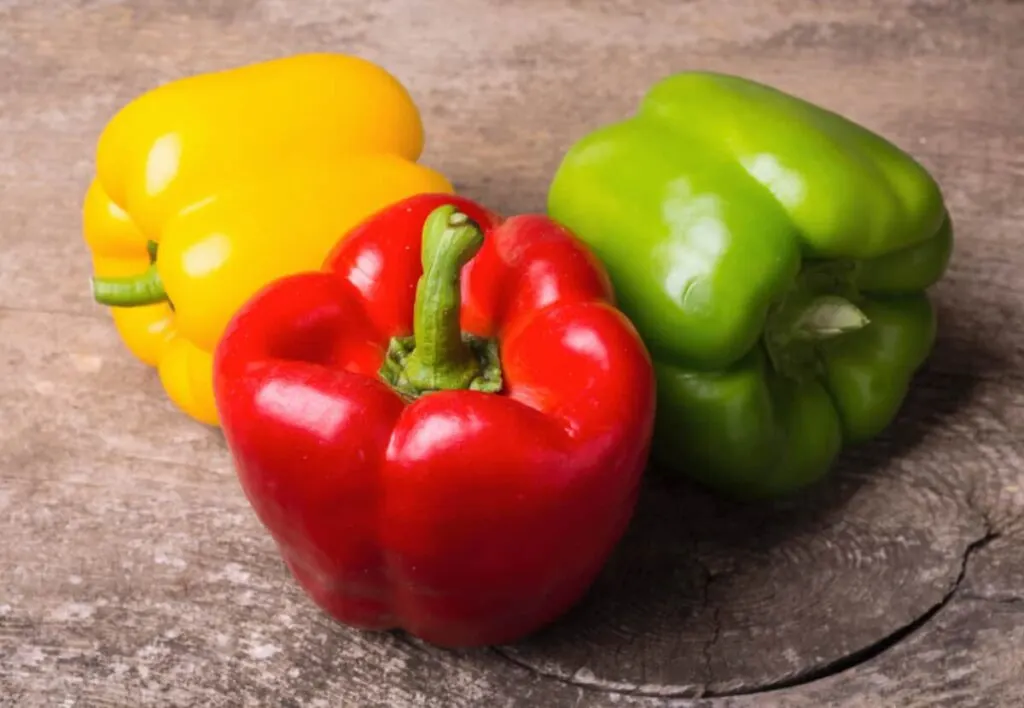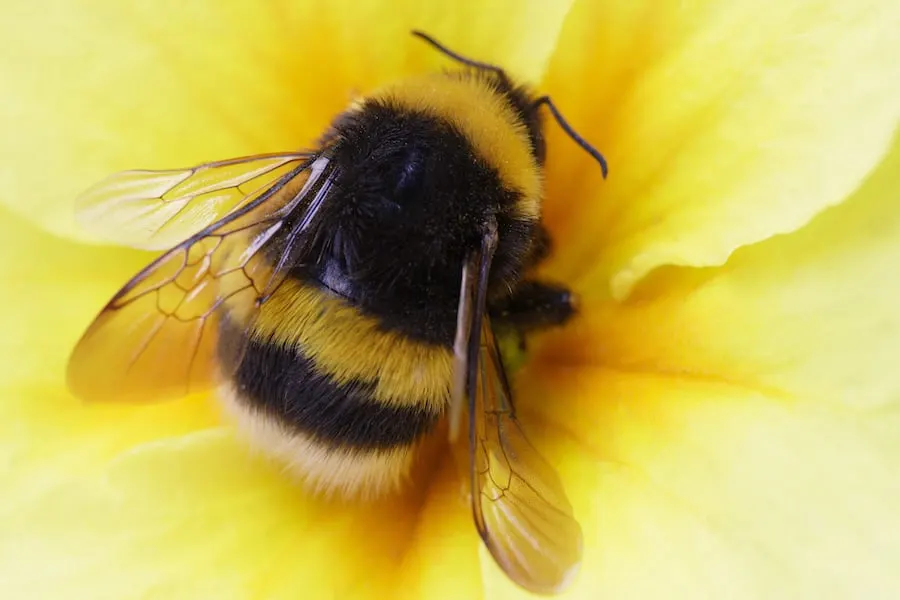Bell peppers are great to cook with as they add a uniquely sweet taste to a wide variety of dishes, salads, sauces, and condiments. Bell peppers, also known as capsicums or sweet peppers in other parts of the world, also have nutritional value and are rich in antioxidants and vitamin C.
Native to Mexico and countries in Central and South America, Bell peppers are fruits that are classified botanically as berries but used as vegetables. They come in many colors like red, green, orange, yellow, and purple. While they are generally sweet, each variety has its own distinct flavor.

This article serves as your one-stop guide to everything you need to know about Bell peppers, including where they originate from, how they are used in cooking and food preparation, their different varieties and colors, their various flavor profiles, and their health benefits.
What are Bell Peppers?
Bell peppers (Capsicum annuum) are berries by botanical classification but are used mostly as culinary vegetables or culinary ingredients, just like tomatoes. The fact that they are produced from a flowering plant and contain seeds makes them fruits, technically speaking. These fruits or peppers are shaped like bells and are usually three to six inches long. They have thick flesh that is juicy and crunchy when eaten raw.
Bell peppers are called different names in different parts of the world. In the United States, Canada, and the Philippines, for example, these fruits are called Bell peppers. While in the U.K. and Ireland, they are simply called peppers or Sweet peppers. And in Australia, New Zealand, India, Sri Lanka, Pakistan, and Malaysia, they are called Capsicums.
Capsicum is a genus of flowering plants in the Solanaceae or nightshade family. And Bell peppers are of the Grossum cultivars, which produce fruits in a variety of colors.
Several varieties of the Capsicum species are called by various names, such as Pepperoncini, Peperoncino, and Jalapeño. Anaheim, Cubanelle, Chili, Cayenne, Cherry, and Banana peppers are also Capsicums. Paprika, meanwhile, is a powdered spice that is made up of several kinds of Capsicums.
Origin of Bell Peppers
Bell peppers are native to Mexico and countries in Central and South America.
The Italian explorer Christopher Columbus and his Spanish companions gave the fruit its “pepper” designation. They were looking for peppercorn plants, which produce black pepper, to bring back to Europe. Black pepper was a highly valued spice or condiment at the time, and explorers were hoping to make a lot of money from the very profitable spice trade.
Columbus and his men brought back to Europe various samples of what they believed were peppers, including the Bell pepper, which is not related to a peppercorn (Piper nigrum). In Europe, the name “pepper” was simply applied to all the spices that featured a pungent smell and a hot taste. This name was extended to the genus Capsicum.
From there, Bell peppers then spread throughout Europe and Asia, and now, they are cultivated worldwide. In the U.S. today, most of the green Bell peppers are grown in Florida. But not very far behind are California, New Jersey, North Carolina, and Texas.
Nutritional Content and Health Benefits of Bell Peppers
You can eat Bell peppers either cooked or raw. You can also dry them for use in powder form. Bell peppers are very rich in antioxidants and in vitamin C, and they are low in calories, so they would make a great addition to your diet.
According to HealthLine, 92 percent of raw Bell peppers are made up of water, with the rest consisting of carbohydrates, which accounts for most of the calorie content, and very small amounts of fat and protein. The carbohydrates are mainly sugars, which are responsible for giving the Bell peppers their sweet flavor. These sugars include glucose and fructose. Bell peppers also have a little fiber.
More specifically, 100 grams (3.5 ounces) of raw red Bell pepper contain these primary nutrients:
- Water: 92 percent
- Calories: 31
- Carbohydrates: 6 grams (0.21 ounce)
- Protein: 1 gram (0.04 ounce)
- Sugar: 4.2 grams (0.15 ounce)
- Fiber: 2.1 grams (0.07 ounce)
- Fat: 0.3 gram (0.01 ounce)
Vitamins and Minerals Present in Bell Peppers

You can also get a load of vitamins and minerals from eating Bell peppers. There’s vitamin C, for one. Vitamin C or ascorbic acid has many health benefits, including helping with the proper growth and development of your body’s tissues, as well as with their repair. It also helps protect your body against immune deficiencies, among many others.
Medium-sized red Bell pepper is one of the richest dietary sources of vitamin C, with 169 percent of RDI or Reference Daily Intake. Green Bell peppers contain twice the vitamin C content of citrus fruits by weight, and red Bell peppers contain more than twice the amount of vitamin C in green Bell peppers.
Other vitamins and minerals that you can find in Bell peppers include:
- Vitamin B6. Also known as pyridoxine, vitamin B6 is a group of essential nutrients that help with the formation of red blood cells and in hemoglobin production. It also helps with brain function.
- Vitamin K1. Vitamin K1, also known as phytomenadione or phylloquinone, is a fat-soluble vitamin that promotes bone metabolism, blood clotting, and regulates blood calcium levels.
- Potassium. This mineral and electrolyte help muscle function, including the muscles responsible for your breathing and heartbeat. It assists in regulating heart rhythm, blood pressure, nerve impulses, digestion, and your pH balance.
- Folate. Folate or vitamin B9 has a wide variety of bodily functions, including the production of white and red blood cells in your bone marrow. It is also essential in the production of RNA and DNA and in the conversion of carbohydrates into energy. This vitamin is very important during pregnancy as it fuels the growth of the fetus.
- Vitamin E. Vitamin E is a fat-soluble antioxidant, and it is essential for healthy muscles and nerves. It helps protect your cells from damage brought about by free radicals.
- Vitamin A. Bell peppers, especially the red ones, are rich in pro-vitamin A or beta carotene. Your body converts beta carotene into vitamin A, which is essential for healthy vision, immune function, cellular communication, and reproduction.
Other Plant Compounds Present in Bell Peppers
Other than vitamins and minerals, Bell peppers also have a host of other plant compounds that are mainly antioxidants. These compounds include:
- Capsanthin. Capsanthin is a potent antioxidant that gives red Bell peppers their bright red color and it may help raise levels of HDL (good) cholesterol, which is associated with a lower risk of heart disease
- Violaxanthin. Violaxanthin is the most abundant carotenoid antioxidant found in yellow Bell peppers.
- Lutein. Lutein is abundant in unripe or green Bell peppers and is absent from ripe ones. Lutein can improve eye health.
- Quercetin. Quercetin is a polyphenol antioxidant that helps prevent certain chronic conditions like cancer and heart disease.
- Luteolin. Similar to quercetin, luteolin is a polyphenol antioxidant that have a variety of health benefits.
Health Benefits of Bell Peppers
- Promotes healthy eyesight. Bell peppers contain high amounts of carotenoids called lutein and zeaxanthin, which help improve eye health and reduce the risk of impaired vision. They protect your eyes’ light-sensitive inside wall, which is called the retina, from oxidative damage. A number of studies found that consuming foods with high carotenoid content like Bell peppers may reduce the risk of macular degeneration and cataracts.
- Helps prevent anemia. Iron deficiency causes anemia, which is characterized by your blood’s reduced capacity to carry oxygen. It is manifested through fatigue and weakness. Bell peppers are an awesome source of vitamin C, which promotes better absorption of iron found in your gut. So, Bell peppers enjoyed alongside foods that are rich in iron can help prevent anemia.
Adverse Effects of Eating Bell Peppers
Some people may be allergic to Bell peppers, although it is quite rare. Those with pollen allergy may also have a sensitivity to Bell peppers as an allergic cross-reaction. Allergic cross-reactivity can take place between certain ingredients or food items because they may have similar allergens.
Colors and Flavors of Bell Peppers

Bell peppers come in red, green, yellow, orange, purple, white, and sometimes brown colors or varieties. The plant’s variety and the fruit’s stage of ripeness are factors that determine each Bell pepper’s particular flavor and color.
Generally, Bell peppers have a mild, sweet flavor, and the more they ripen, the sweeter they get. As such, red Bell peppers are expectedly sweeter than the green ones, which are unripe and therefore taste sharper. The orange variety, meanwhile, is less flavorful compared to the red.
Unripe, green Bell peppers will eventually turn into another color, like red or orange, as they mature. Their flavor will also become more mellow as they ripen, and their sugar content will increase.
There are some varieties, though, that don’t start out green. Light yellow and ivory peppers will develop in the same color as they ripen. Brown-colored peppers, meanwhile, have brown skin, but they are green on the inside and turn green when they are cooked.
As for purple Bell peppers, depending on their variety, they will start out either white or green and will then turn into a deep purple as they ripen. If these purple Bell peppers are not harvested right away, they will eventually turn red. Purple Bell peppers will also become green when they are cooked.
Male vs. Female Bell Peppers
There is a common misconception that there is a distinction between male and female peppers, but that is not true. Many people claim that you can identify between male and female peppers by the number of lobes on the bottom of the pepper, where Bell peppers with four lobes at the bottom are female, they produce more seeds, and are sweeter than their male counter parts which have three lobes on the bottom.
However, there is no truth to any of this! Bell peppers don’t have a sex—you can read more about this in our other post.
Bell Pepper Varieties
Some of the common varieties of Bell peppers include:
- Candy Apple. Candy Apple is an early-fruiting variety of Bell pepper as it produces fruits in around 70 days. These peppers are sweet, and they grow up to five inches long.
- California Wonder. Also called Sweet California Wonder, this four-inch, dark red heirloom Bell pepper would be great to use in your stuffed pepper recipe.
- Golden Bell. Golden Bells start out green, but they turn goldish yellow as they ripen. These peppers have a sweet taste with a nice crunch and they typically mature in 65 to 75 days.
- Cabernet. Cabernet Bell peppers are elongated at eight inches long. The fruits are glossy, and they turn from green to red as they mature. They also have a very sweet flavor.
- Carmen. Carmen Bell peppers are tapered fruits that go from green to deep red. These peppers are six inches long and are a type of Italian Corno di toro or bull horn pepper.
- Gourmet. Gourmet Bell peppers are an attractive bright orange when they are ripe. They have juicy, sweet flesh.
- Cupid. Cupids can be harvested green at 55 days, or you can wait 75 days for them to turn red and sweet. These fruits come from big plants with a nice spread of branches.
- Sweet Chocolate. Sweet Chocolate Bell peppers are chocolate-hued with brick-red flesh. They are smooth-skinned, and their shape tapers to stubby and blunt ends. These peppers are mild-flavored.
- Lunchbox. Lunchbox peppers are mini-sized. They are sweet and would fit perfectly in snack bags and can also be added to salads. The fruits are either yellow, orange, or red.
- Moonset. Moonset Bell peppers are great eaten fresh and raw, but they are also suitable for frying or stuffing. The fruits are medium-sized and start as green, turning to golden-yellow as they mature.
- Islander. These Bell peppers boast pale lavender skins with streaks of orange or yellow. They mature to dark red fruits. Their flesh is pale yellow, and they have a mild and slightly sweet taste.
- Sweet Sunrise. Sweet Sunrise Bell peppers are fruity-flavored. They are medium-large and can be harvested in 65 days. They start as green fruits that turn yellow-orange as they ripen in 85 days.
- Intruder. Intruder Bell peppers are big, green fruits with a blocky shape. These peppers also have thick walls. This variety is well-adapted to the Northeastern part of the U.S.
- King Arthur. King Arthur Bell peppers are four- to five-inch fruits that you can harvest in 60 days. These green peppers will turn bright red and, regardless of maturity, they are sweet and crunchy.
- Good as Gold. This Italian variety of Bell pepper has a complex flavor as it is sweet and savory at the same time. These fruits are perfect for roasting and grilling, but you can also chop them up and toss them in your salad.
- Gypsy. Gypsy Bell peppers are a tried-and-tested variety. These are four-inch fruits that taper in shape. They are sweet when they have ripened from golden-green to orange, then to red.
How Hot Are Bell Peppers on the Scoville Scale?
Bell peppers have zero Scoville Heat Units.
The Scoville scale measures the spice or heat level of peppers. More specifically, it measures the pepper’s capsaicin content. Capsaicin is a lipophilic chemical compound in peppers, mostly found in their ribs and seeds, and it is responsible for their spicy heat. This is the chemical that causes a burning sensation in your tongue and makes your ears ache and your body sweat after you eat a hot pepper or after capsaicin comes into contact with your mucous membranes.
Scoville Heat Units (SHU) are the units of measurement for the Scoville scale. SHU refers to the amount of capsaicin that is present in the pepper. To get the SHU, you dry a bell pepper and extract capsaicin oil via alcohol distillation. The extract is then diluted in a sugar-water solution. A Scoville Heat Unit is assigned with respect to how much dilution is needed until the panel of taste-testers won’t detect the heat.
Take, for instance, a Cayenne pepper, which has a Scoville level of 30,000 to 50,000 SHU. This means that the oil obtained from the cayenne pepper extract has to be diluted 30,000 to 50,000 times before its heat becomes barely detectable.
In the case of bell peppers, it has zero SHU. This means it is not hot at all, and no sugar-water dilution is necessary. In fact, bell peppers are the only member of the Capsicum genus that doesn’t produce capsaicin.
Cooking with Bell Peppers
Bell peppers add crunch, color, and sweetness to a wide array of recipes. As a rule, Bell peppers that are more colorful and are sweeter are better eaten raw or added to salads. Green pepper, which is unripe and tastes less sweet, is generally better for cooking.
Bell peppers also make great toppings on a pizza. They also taste great roasted by themselves or roasted or stir-fried with other vegetables. You can also make stuffed peppers, where they are sliced in half and hollowed out to make space for various types of fillings, which can be a combination of ingredients like meat, potatoes, onions, eggs, spinach, and other vegetables.
The cooking spice paprika is also made of a combination of dried Bell peppers and other types of peppers. Bell peppers are also used to make salsas and different kinds of sauces and condiments.
How to Choose Bell Peppers for Cooking
When buying Bell peppers for cooking or food preparation, pick ones that are bright, firm, and have a glossy skin. Stay away from bell peppers with soft spots, moldy stems, cuts, and wrinkled skin.
You might also need to consider the time of the year when picking Bell peppers. Green pepper is typically available all year round, while other colors may be seen at the produce aisle only during their peak season or from July to October.
Growing Bell Peppers
Bell pepper plants are a warm season crop. They prefer their soil warm yet moist, ideally in temperatures ranging from 70 to 84 degrees Fahrenheit (21 to 29 degrees Celsius). In tropical regions, Bell peppers are perennials. However, since they do not tolerate cold weather, they are grown as annuals in places with colder climates, unless they are properly overwintered.
The plants are bred through seeds, and they can be grown in various types of soil. However, loamy soil tends to warm faster during the spring, so it is a good soil to use for early planting. Ideally, the pH levels of the soil should be between six and seven. It is also important to plant your Bell pepper in well-draining soil in a large container, directly on the ground, or on a raised bed. Pick an area that gets full sunlight for the most part of the day.
We have a comprehensive post on how to grow Bell peppers, but here is a quick summary.
Starting Your Bell Pepper Seeds
When planting your Bell pepper seeds, it is best to start them indoors if you live in a cooler climate as they require a relatively long growing season of 60 to 90 days. Plant your seeds around eight to 10 weeks before the last day of frost in the spring. The last day of frost in spring can be determined by the average date of the last light freeze taking place in spring.
You can calculate frost dates in your area by using data from NOAA’s National Centers for Environment Information website. Frost has a 30 percent probability of actually happening after the given spring dates.
You can only sow your seeds directly into the ground if you are in an area where the growing season for fruits and vegetables is long and warm. Otherwise, your seeds are best sown in seedling trays that have been filled with sterile seedling potting medium. To achieve high germination rates, water your seeds lightly and don’t allow them to dry out.
Additionally, position your seedling trays in a warm, bright window that is south facing. You can also place it under fluorescent lighting in the absence of a window or limited natural sunlight.
The optimum soil temperature for germination of Bel pepper plants is 70 to 85 degrees Fahrenheit (21 to 29 degrees Celsius). You can expect seedlings to emerge within eight to 25 days. For more detailed information, be sure to check out our post on seed germination.
Transplanting Bell Pepper Seedlings
The Bell pepper seedlings are ready to be transplanted to slightly larger pots after they have each developed a pair of true leaves.
Introduce fertilizer to your soil about a week before you’re set to transplant your Bell pepper seedlings into the garden. In place of fertilizer, you can also use aged compost. Avoid planting your seedlings where you have recently grown other plants within the nightshade family, like eggplants, potatoes, and tomatoes, as this could expose your Bell peppers to disease.
Bell peppers should be transplanted two to three weeks after the last frost. During this time, the temperature of the soil should have reached a minimum of 60 degrees Fahrenheit (15.5 degrees Celsius). If you live in a colder region, you can help bring the temperature of the soil up quicker by covering it with mulch or dark plastic a week before you plan to transplant.
Approximately seven to 10 days before the transplant, set your Bell pepper plants outside for a few hours every day so that they can start to harden off. The process of hardening off, which is gradually acclimatizing plants that are sown indoors to outdoor conditions, is essential as Bell peppers are susceptible to shock after transplant if they are rushed into outdoor conditions. Prepare the planting site by adding lots of organic matter which will encourage vegetative growth.
Side dress your newly transplanted seedlings with a nitrogen fertilizer. Rather than overhead irrigation, use a spray or drip irrigation to keep your plants moist and to water them evenly. Mulching around your plant’s base can also help conserve moisture in the soil.
Pollination and Fruit Production in Bell Pepper Plants

Bell pepper plants produce fruits when their flowers are pollinated. The white flowers are self-fertile, which means that they can pollinate themselves with the help of pollinators like bees or through natural breeze. The important thing is that their pollen drops from the anther, which is the male part, onto the female pistil part.
If you are growing your plants in a sunroom or in a greenhouse, where bees and breeze can’t get in, then you may want to add an oscillating fan. It would mimic the wind and shake the blooms. You can also tap the stems of the flowers lightly with your hands to shake them. Another option is to hand-pollinate each flower by swirling a small paintbrush from one flower to another.
Harvesting Bell Peppers
Depending on the Bell pepper variety, fruits can take about 60 to 90 days to ripen. Green peppers are unripe, so they are rather sharp and bitter. The longer you leave the fruit on the plant, the likelier it will get the chance to evolve into another color and the sweeter it will get.
- Use a garden cutter or a sharp knife to separate the fruit from the plant
- Leave about one inch of the stem intact
- Do not tear the fruit with your hands so as not to disturb the plant
How to Store Bell Peppers Once Harvested
The best way to store Bell peppers and keep them fresh is to refrigerate them unwashed inside a plastic bag.
You can store green peppers and keep them fresh for up to one week. Meanwhile, colored Bell peppers can be stored for several days. The colored Bell peppers won’t last as long as the green ones since they have a higher sugar content.
Make sure to wash your bell peppers before using them.
You can also store peppers in the freezer if you have an abundance of peppers, and this way they can last a few months. Check out our post on how long Bell peppers last and the best ways to store them for more information.
Closing Thoughts
Although technically fruits, Bell peppers are used as culinary vegetables and they add great flavor to many different dishes They are sweet and have absolutely zero heat level, according to the Scoville test. In addition to their beautiful colors and delicious flavors, they are also packed with vitamins and minerals.
They usually start as green and turn to other colors as they ripen, and the more they mature, the sweeter they get. You can enjoy them either cooked or fresh and raw and they go well with so many other ingredients because of their mild flavor.
